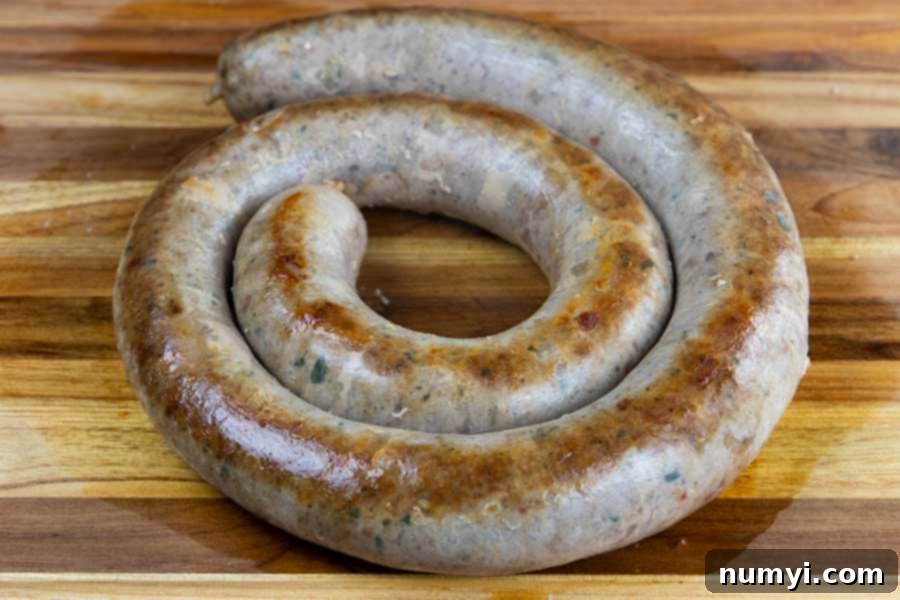Authentic Homemade Italian Sausage Recipe with Fennel: A Rich Family Tradition
Originally published: 03/26/2020 Updated 09/13/2023
There’s nothing quite like the savory aroma and robust flavor of homemade Italian sausage. Far superior to any store-bought variety, crafting your own Italian sausage at home allows you complete control over the ingredients, ensuring a product free of fillers and packed with pure, authentic taste. This recipe, a treasured family heirloom passed down through generations and perfected over time, brings the essence of traditional Italian cuisine right into your kitchen. Prepare to discover how surprisingly easy and incredibly rewarding it is to make your own delicious, juicy, and flavorful fennel sausage.
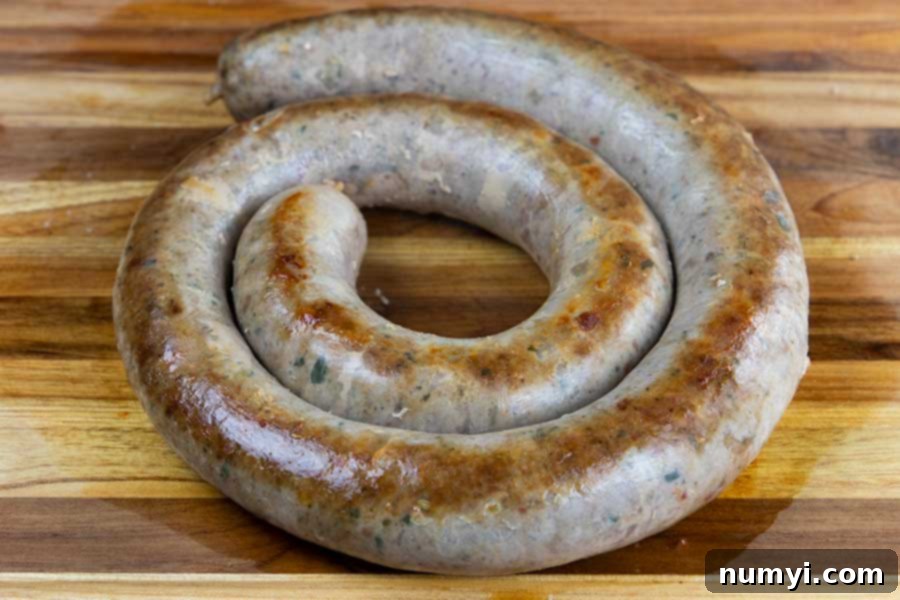
Don’t Sweat The Recipe is supported by its readers. We may earn a commission if you purchase through a link on our site. Learn more.
Why You’ll Adore This Homemade Italian Sausage Recipe
This Italian fennel sausage recipe is not just a dish; it’s a culinary journey rooted in tradition and bursting with incredible flavor. Every Italian family boasts their own unique sausage recipes, and this particular version began as my grandfather’s cherished creation. Over the years, my sister and I have lovingly adapted and refined it, bringing you a truly authentic taste experience that honors its origins while embracing modern preferences.
Homemade Italian sausage has always been a significant tradition in our family. When our aunts eventually stepped back from the labor-intensive process, my sister and I felt a strong desire to keep the delicious legacy alive. We took my grandfather’s original recipe and introduced a few thoughtful adjustments, aiming to enhance the flavor and texture even further. My grandfather initially used a combination of ground beef and prepackaged pork sausages, which was common in his time.
However, my husband and I envisioned a more robust, truly authentic taste and a richer, more satisfying texture. After extensive testing, countless batches, and meticulous adjustments to the spice blend and pork selection, we finally perfected the recipe we are thrilled to share with you today. This isn’t just a recipe; it’s a piece of our heritage, redesigned for maximum enjoyment and unparalleled quality.
We are confident that once you try our delicious homemade Italian sausage, you will fall in love with its deep, complex flavors and superior texture. It’s perfect for elevating everyday meals and creating memorable culinary moments. I frequently substitute commercial breakfast sausage with this flavorful fennel sausage in our Sausage Muffins without Bisquick recipe. Its versatility extends beautifully to hearty dishes like Sausage Lentil Soup, the classic Zuppa Toscana, and even beloved appetizers like Classic Sausage Balls. Its distinct profile makes it a star ingredient in countless Italian-inspired meals.
Key Ingredients for Superior Homemade Italian Sausage
Crafting exceptional Italian sausage begins with selecting the right ingredients. Each component plays a vital role in achieving that perfect balance of flavor and texture:
- Pork – For this recipe, we exclusively use a boneless pork butt, also widely known as pork shoulder. This cut is ideal because it possesses the perfect amount of intramuscular fat marbled throughout the meat. This fat is absolutely essential for producing tender, juicy, and incredibly flavorful pork sausage. Avoid lean cuts, as they will result in dry, crumbly sausage. The fat renders during cooking, keeping the sausage moist and distributing the rich flavors of the seasonings.
- Seasonings – The soul of Italian sausage lies in its aromatic spice blend. Our carefully curated mixture includes:
- Crushed Red Pepper Flakes: To provide a pleasant, subtle kick that complements the other flavors without overpowering them. Adjust to your heat preference.
- Fennel Seeds (Whole and Ground): Fennel is the signature flavor of Italian sausage. Using both whole seeds for bursts of anise-like flavor and ground fennel for a more integrated aroma ensures a robust fennel profile. If you can’t find ground fennel, easily grind whole seeds in a coffee grinder.
- Red Wine: A dry red wine adds depth, complexity, and a touch of acidity, helping to meld the flavors and tenderize the meat.
- Fresh Garlic: Minced garlic provides a pungent, aromatic base that is quintessential to Italian cooking.
- Seasoning Salt, Kosher Salt, and Fresh Ground Black Pepper: A balanced salt content is crucial for both flavor and preservation. Freshly ground pepper offers a brighter, more intense heat than pre-ground varieties.
- Fresh Italian Flat Leaf Parsley: Adds a fresh, herbaceous note that brightens the overall flavor.
- Dry-Rubbed Sage: Contributes an earthy, slightly peppery flavor that pairs wonderfully with pork and fennel.
- Casings – While you can certainly make delicious bulk Italian sausage without casings (perfect for patties or crumbles), using casings elevates the experience, creating traditional links or coils. We highly recommend using all-natural hog casings for their authentic texture and permeable nature, which allows for better flavor development and a satisfying snap when cooked. Alternatively, synthetic casings are available. We have found excellent results with Pre-Tubed Natural Hog Sausage Casings, 35-38mm, which can be conveniently purchased online.
How To Make Authentic Homemade Italian Sausage: A Step-by-Step Guide
Making your own Italian sausage might seem daunting, but with the right steps, it’s a straightforward and enjoyable process that yields incredibly delicious results.
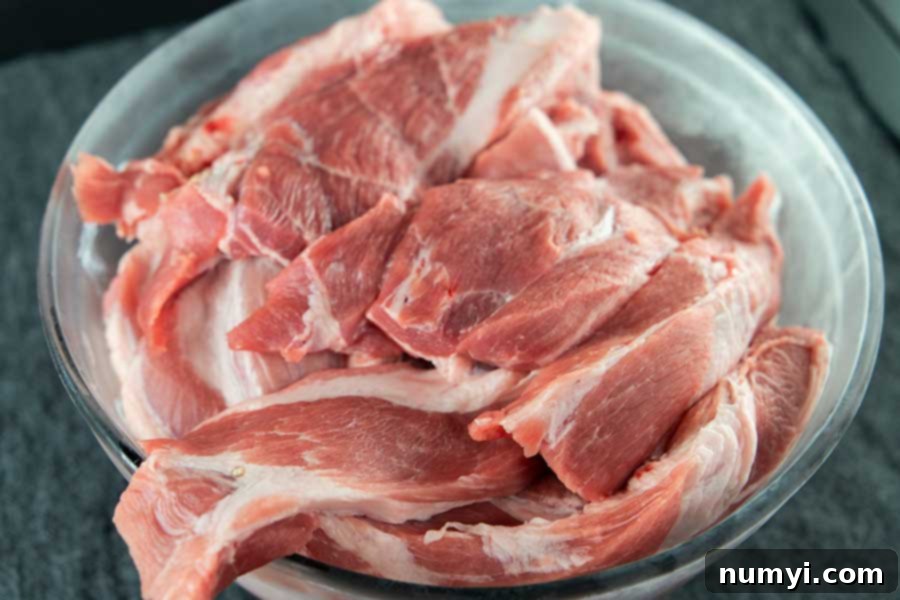
1. Prepare the Pork: Begin by cutting the boneless pork butt into strips or cubes that are small enough to easily fit into your meat grinder. It’s crucial to leave all the fat attached to the meat, as this is key to juicy, flavorful sausage. Carefully inspect the pork and remove any tough sinew, silver skin, or connective tissue, as these can create an unpleasant chewy texture in your final product. Discard these fibrous bits.
2. Chill the Meat and Equipment: This is perhaps the most critical step for excellent sausage texture. Place the prepared pork pieces and all your sausage-making equipment (meat grinder components like the housing, blade, and plate, and even your mixing bowl) into the freezer for 30-60 minutes. You want the meat to be very firm and partially frozen – almost crunchy on the outside, but not frozen solid. This ensures the fat remains hard during processing. If the fat softens or “smears,” it won’t emulsify properly with the lean meat, resulting in a greasy, crumbly texture rather than a cohesive, juicy sausage.
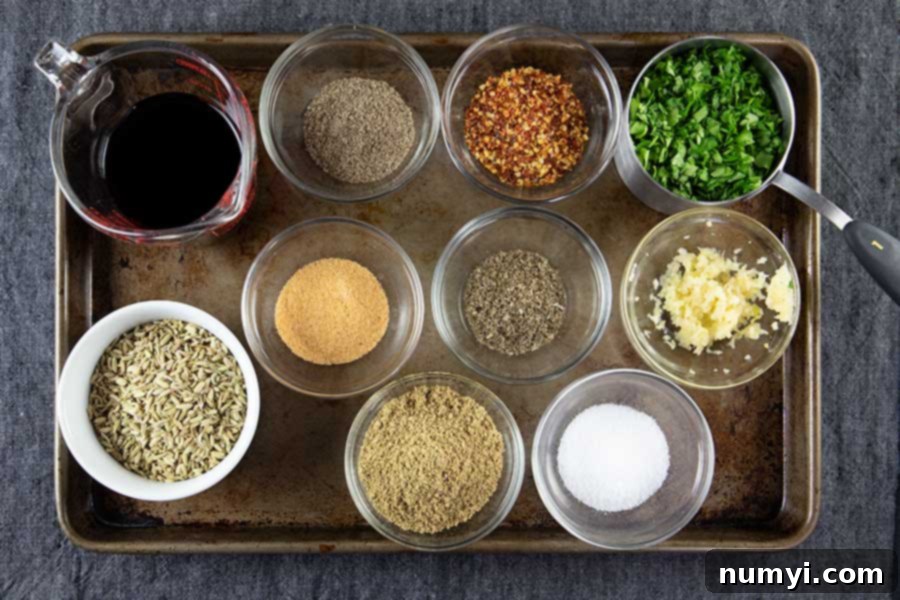
3. Prepare the Seasonings: While the pork is chilling, measure out all your spices and aromatics: whole fennel seed, crushed red pepper flakes, dry-rubbed sage, fresh ground black pepper, seasoning salt, ground fennel, finely chopped fresh Italian parsley, kosher salt, minced garlic, and dry red wine. Have them all ready in separate small bowls or a single larger bowl for easy addition. This preparation makes the mixing process much smoother.
4. Prepare the Casings: If you’re using natural casings, they typically come packed in salt to preserve them. You’ll need to thoroughly rinse them first. Run cool water over and through the casings to remove all residual salt. Then, place them in a bowl of fresh, cool water to rehydrate and become more pliable. To make handling easier, drape one end of each casing over the side of the bowl; this simple trick prevents you from struggling to find the opening when it’s time to stuff.

5. Grind the Pork: Remove the chilled meat grinder equipment from the freezer and assemble it according to the manufacturer’s instructions. A quick tip (and a required step in our family tradition!): pour yourself a glass of that dry red wine you’re using in the recipe to enjoy during the process! Begin grinding the partially frozen pork. We typically use the small-holed plate for a finer, more traditional Italian sausage texture, but you can opt for a larger-holed plate if you prefer a coarser grind. Grind the pork directly onto a large, chilled sheet pan. Spreading the ground meat evenly on the pan helps keep it cold and facilitates easier, more uniform mixing of the spices.
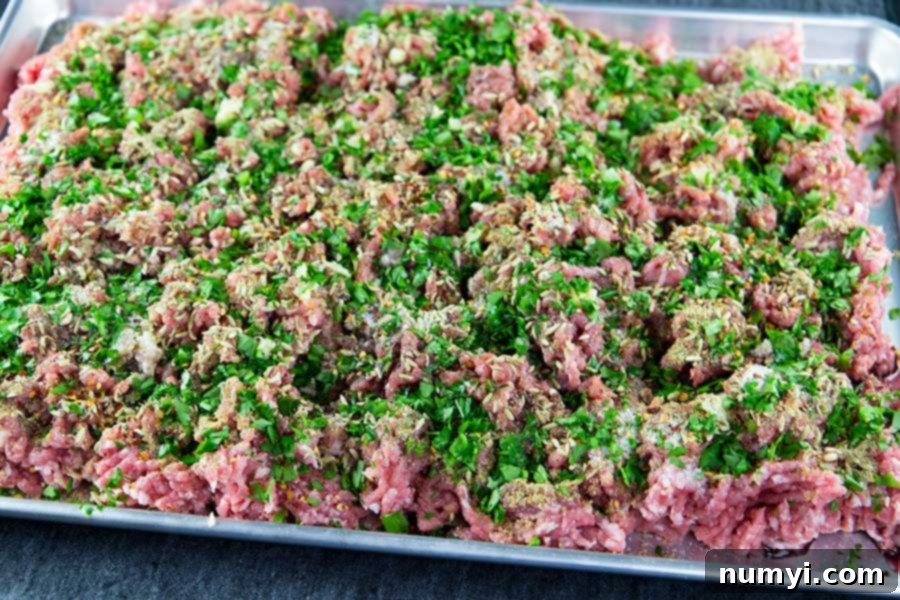
6. Season and Mix: Evenly sprinkle all the prepared spices and herbs over the ground pork. Then, using your hands (make sure they’re very clean or wear gloves!), mix the ingredients thoroughly until everything is well combined and evenly distributed throughout the meat. This is essential for consistent flavor in every bite.
Taste Test: To ensure the flavor is perfect before stuffing, take a small sample of the seasoned meat (about a tablespoon), form it into a small patty, and cook it in a skillet until browned through. Taste it and adjust the seasonings as needed – perhaps a little more salt, pepper, or red pepper flakes. This step is crucial for customizing the flavor to your liking. Once you’re satisfied, place the remaining seasoned sausage mixture back into the freezer or refrigerator to keep it cold while you prepare the stuffing process.
7. Prepare for Stuffing: If using pre-tubed casings, carefully load them onto your sausage stuffing tube, following the package instructions. You can rub the stuffing funnel with a little olive oil or even some water to help the casing glide on smoothly and prevent tearing. Ensure your sausage stuffer is assembled and ready.
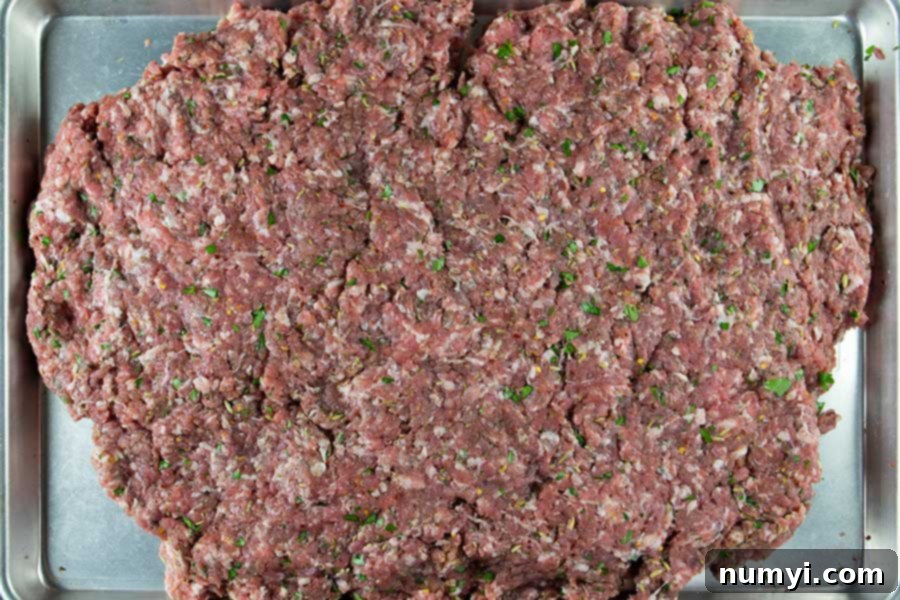
8. Stuff the Sausage: Once you are completely happy with the taste of the seasoned sausage mixture, load the stuffer’s hopper with some meat. Pump a small amount through to remove any trapped air from the stuffer tube. Attach a casing to the end of the nozzle, ensuring it’s snugly fitted, and tie off the open end of the casing. Now, remove the bulk meat from the fridge and begin pumping it into the casing.
The Balancing Act: This step requires a delicate touch. You need to pump the meat into the casing carefully, trying to avoid any air pockets. There’s a balance to strike:
- Too much air: Will result in poorly formed, loose sausages that can dry out.
- Too little air: The casing will be too taut and could burst during stuffing or cooking.
Aim for a firm but not overly tight sausage. If you have a helper, this part of the process becomes much easier, with one person loading the meat and the other gently guiding and forming the casing.

9. Form the Links: Once stuffed, form the sausage into your desired length. Many prefer to make them into long coils or individual links. To create links, gently pinch and twist the casing at your desired intervals. Stop filling the casing with approximately 3 inches to spare at the end, then tie off the final end securely. Repeat this process until all the delicious meat mixture has been stuffed into casings. We often make them into coils weighing 1 to 1.5 pounds for convenience, but you can also create smaller, single-serving links or leave it as bulk sausage.

10. Storage and Flavor Development: We typically freeze the majority of our homemade sausage, saving out enough for immediate dinner plans or snacks. It’s worth noting that the flavors in homemade Italian sausage combine and deepen significantly as it sits. Sausage made and cooked on the same day will taste wonderful, but allowing it to rest for at least 24 hours in the refrigerator, or even after freezing and thawing, will result in a more intense and complex flavor profile. This “aging” period allows the spices to fully permeate the meat.
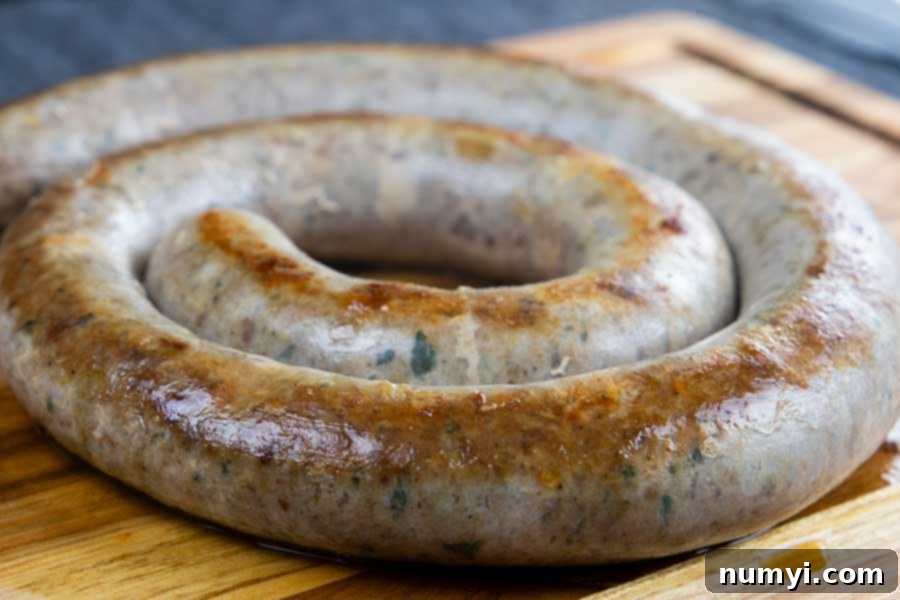
11. How to Cook Homemade Italian Sausage:
- Choose a skillet large enough to comfortably hold the size of the sausage you’ve made (links, patties, or coils). Place it over medium-high heat.
- Add 1 tablespoon of olive oil to the hot skillet.
- Carefully place the Italian sausage in the skillet. Cook, covered, for about 15 minutes. Covering the pan helps to cook the sausage through gently and evenly, preventing the casing from drying out too quickly.
- Remove the lid and continue to cook uncovered for an additional 5-10 minutes, or until the sausage is beautifully browned and reaches an internal temperature of 160-165 degrees F. Always use a meat thermometer to ensure food safety and prevent overcooking, which can lead to dry sausage.
Delightful Serving Suggestions for Your Italian Sausage
The versatility of homemade Italian sausage makes it a fantastic addition to countless meals. Here are just a few ideas to inspire you:
- Sausage and Peppers: This classic combination is a perfect match for your flavorful homemade Italian sausage. Sauté bell peppers and onions with the sausage for a hearty sandwich or a main course.
- Breakfast Elevated: Forget the bland breakfast sausages! Substitute them with your homemade Italian sausage for a truly memorable morning meal, whether in scrambles, alongside eggs, or as part of a breakfast casserole.
- Pizza Topping: Crumble the cooked sausage over your favorite homemade pizza dough for a burst of savory, spicy flavor. It pairs beautifully with classic tomato sauce and mozzarella.
- Bulk Meal Prep: Freeze cooked or uncooked bulk sausage in 1-pound packages. This makes it incredibly convenient to pull out for quick weeknight dinners, adding instant flavor to pasta sauces, stews, chilis, or sautéed vegetables.
- Pasta Dishes: Integrate crumbled Italian sausage into rich tomato sauces for pasta like penne, rigatoni, or spaghetti. It’s also excellent in lasagna or baked ziti.
- Soups and Stews: Add incredible depth to comfort food favorites. Think minestrone, white bean soup, or a hearty potato and kale soup.
- Grilling: Grill whole links of Italian sausage until charred and cooked through for a delicious summer BBQ option. Serve in a bun with your favorite toppings.
Expert Tips for Perfect Homemade Italian Sausage
Achieving outstanding homemade Italian sausage is easy with a few key insights:
- Pork Choice: While grinding your own boneless pork butt is highly recommended for optimal fat content and control, you can use pre-ground pork. If you do, ensure it has a good fat ratio (around 70/30 or 80/20 lean to fat) for a juicy sausage.
- Adjusting the Heat: Our Italian sausage recipe is designed to have just the right amount of pleasant heat from the crushed red pepper. However, taste preferences vary greatly. Feel free to cut down on the amount of crushed red pepper flakes for a milder sausage, or increase it if you prefer a spicier kick.
- The Importance of Cold: Always ensure your pork and all sausage-making equipment are thoroughly chilled, ideally partially frozen, before grinding and mixing. This prevents the fat from smearing and helps create a superior texture and emulsion. A bowl of ice underneath your mixing bowl can also help keep the meat cold during seasoning.
- Casing Preparation: Follow the package instructions for your chosen casings precisely. Proper rinsing and rehydration are crucial for making them pliable and easy to stuff.
- Versatile Forms: This recipe isn’t just for links! You can easily form the seasoned ground meat into Italian sausage patties, or leave it as bulk sausage by the pound to crumble into dishes.
- Avoid Overcooking: Overcooked sausage becomes dry and tough. The best way to ensure perfectly cooked, juicy sausage is to use a reliable digital meat thermometer and cook it until it reaches an internal temperature of 160-165 degrees F.
- Cleanliness is Key: When working with raw meat, maintaining impeccable hygiene is paramount. Thoroughly clean all equipment and surfaces, and wash your hands frequently to prevent cross-contamination.
- Consider a Stand Mixer Attachment: If you own a stand mixer, a meat grinder attachment can make the grinding and even stuffing process (with a sausage stuffer attachment) incredibly efficient and easy.
Frequently Asked Questions About Homemade Italian Sausage
The terms “fennel sausage” and “Italian sausage” are often used interchangeably, especially in the United States. Fennel sausages are quite simply sausages that incorporate fennel as a primary flavoring. The vast majority of “Italian sausage” varieties sold commercially in the US, particularly sweet or mild Italian sausage, contain fennel. However, authentic Italian sausage, especially those made traditionally in different regions of Italy, may or may not include fennel. The specific seasoning blend, including the presence or absence of fennel, is often a matter of regional tradition and individual family preference. This particular recipe highlights the beloved fennel flavor that many associate with classic Italian sausage.
A broken casing can be frustrating, but it’s a common occurrence and easily remedied. Don’t panic! Simply cut off the section of the casing that has broken. Carefully squeeze the exposed fennel sausage meat back into the stuffer’s hopper. Pull the remaining intact casing a few inches off the funnel, tie another knot at the new end, and then resume the stuffing process. You might lose a small portion of casing, but the delicious meat will be salvaged. Just try again, being mindful of the pressure you’re applying and the amount of air in the casing.
Since homemade Italian sausage contains no fillers or preservatives, it will not last as long in the refrigerator as commercially prepackaged sausage. For immediate use, store only the amount you plan to cook within the next 1-2 days in an airtight container in the fridge. For longer storage, it’s essential to freeze the remaining sausage promptly to maintain its freshness and quality. Proper storage is key to enjoying your homemade creation safely.
To ensure your homemade sausage stays fresh and flavorful in the freezer, wrap it tightly in freezer paper, heavy-duty aluminum foil, or place it in freezer-safe bags. For best results and extended freezer life, we highly recommend using a vacuum sealer for this process. Vacuum-sealed sausage can be stored for up to 3 months without significant loss of quality or flavor. Label packages with the date to keep track of freshness.
Absolutely! While a sausage stuffer is ideal for creating links, you can easily make this recipe as bulk Italian sausage. Simply follow all the steps for preparing and seasoning the meat. After the taste test, instead of stuffing into casings, divide the mixture into desired portions (e.g., 1-pound blocks), wrap them tightly, and store them in the refrigerator or freezer. This bulk sausage is perfect for crumbling into sauces, forming into patties, or using in any recipe that calls for ground Italian sausage.
More Recipes Featuring Homemade Italian Sausage
Italian Sausage Rigatoni with Spicy Tomato Cream Sauce
Foolproof Baked Ziti With Italian Sausage
Absolute Best Ever Lasagna Recipe
Are you on Pinterest? Click the button below to add this recipe to one of your boards!

Homemade Italian Sausage Recipe
Print
Pin
Rate
Equipment
-
Meat grinder
-
Sausage stuffer
Ingredients
- 8 lbs Pork butt (boneless pork shoulder)
- 6 Tbsp Whole fennel seeds
- 2 Tbsp Crushed red pepper flakes (or less, to taste)
- 2 tsp Dry rubbed sage
- 1 Tbsp Fresh ground black pepper
- 1 Tbsp Seasoning salt
- 4 Tbsp Ground fennel
- 3/4 cup Fresh Italian parsley, finely chopped
- 1 Tbsp Kosher salt + 1 teaspoon
- 6 cloves Garlic, minced
- 1/2 cup Dry red wine
- Sausage casings (natural hog casings recommended)
Instructions
-
Cut the boneless pork butt into strips or cubes, ensuring all fat remains attached. Remove and discard any sinew or silver skin. Place the cut pork pieces and all your meat grinding and stuffing equipment into the freezer. Chill until the meat is very firm but not frozen solid, about 30-60 minutes.
-
While the pork chills, prepare all the seasonings: whole fennel seed, crushed red pepper flakes, dry rubbed sage, fresh ground black pepper, seasoning salt, ground fennel, finely chopped fresh Italian parsley, kosher salt, minced garlic, and dry red wine. Set these aside in separate bowls.
-
Prepare the casings: Rinse the casings thoroughly under cool running water and through the insides to remove all packing salt. Place them in a bowl of fresh, cool water to rehydrate and make them pliable. Drape one end of each casing over the side of the bowl for easy access.
-
Remove the chilled meat grinder equipment from the freezer and assemble it according to manufacturer instructions.
-
Grind the partially frozen pork using the small-holed plate (or large, if preferred) directly onto a large, chilled sheet pan. Spread the ground meat evenly across the pan to keep it cold.
-
Evenly sprinkle all prepared spices and herbs over the ground pork. Using clean hands, mix thoroughly until all ingredients are well combined and evenly distributed. Take a small sample, cook it in a skillet, and taste to adjust seasonings as desired. Place the remaining sausage mixture back into the freezer or refrigerator to keep it cold while preparing for stuffing.
-
Once satisfied with the flavor, load the stuffer’s hopper with some meat and pump a small amount through to remove any air. Attach a prepared casing to the end of the nozzle and tie off the open end securely.
-
Begin pumping meat into the casing, carefully maintaining an even flow to avoid excessive air pockets or over-stuffing, which could cause the casing to burst.
-
Form the sausage into desired lengths by gently pinching and twisting the casing, or leave as a long coil. Stop filling the casing with about 3 inches remaining at the end and tie off securely. Repeat until all meat is stuffed. For optimal flavor development, store in the refrigerator for at least 24 hours, or wrap and freeze desired portions for longer storage.
To Cook The Italian Sausage
-
Place a large skillet over medium-high heat. Add 1 tablespoon of olive oil.
-
Add the Italian sausage, cover the skillet, and cook for about 15 minutes. Remove the lid and continue to cook uncovered for 5-10 minutes more, or until the internal temperature reaches 160-165 degrees F.
